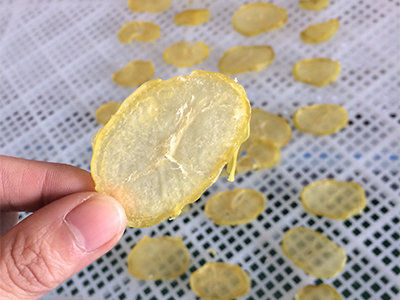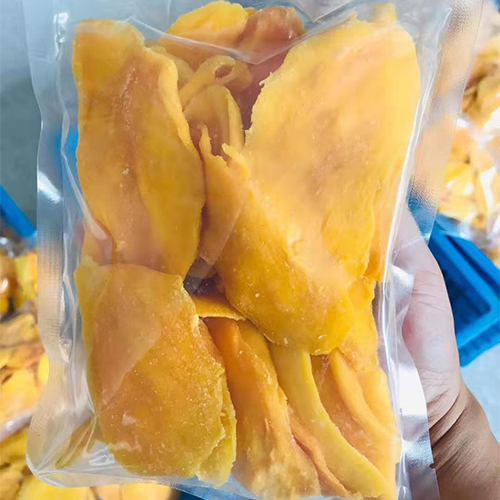
Grape Dehydration
When grapes are dried, they become extremely sweet. They go well with trail mix and rehydrated fruit cocktail.
Before and after dehydrating grape slices.
Before and after photos of dehydrating sliced grapes.
Use seedless grapes for this recipe.
Grapes must be cut crosswise three times to dry; otherwise, they will take significantly longer to dry if just cut in half. They stick a little to mesh sheets, but once properly dried, they fall off easily.
Dehydrate grapes for 18-20 hours at 135°F (57°C), or longer if necessary. They will be flexible and sticky. Green grapes will turn golden yellow when cooked. Purple grapes will darken and develop green insides.
After conditioning, store dehydrated grapes in an airtight container.
Lemons and limes dehydrated
While oranges dry perfectly well at 135°F (57°C), lemons and limes will turn brown.
Turning down the temperature and shortening the drying time with selective slicing and drying is the best approach to dehydrate lemons and limes.
First, wash the fruit.
For dehydration, learn how to slice a lemon.
Step 2: Cut the fruit in half lengthwise. Cut lemons crosswise into 18-inch thick slices, cut-side down. To cut small slices without expelling much juice, a very sharp chef's knife is the best instrument.
Step 3: Arrange lemon/lime slices on a dehydrator tray lined with a nonstick sheet. Slices should be placed with the cut side facing the direction of the wind.
Lemon slices split in half on a nonstick baking sheet.
Fourth, dehydrate the lemons and limes at 115°F (46°C). Set the timer for 12 hours.
After an hour, there should be no loose juice around the lemon segments. Place the lemon slices on a mesh tray lined with a nonstick sheet. Continue drying for 12-14 hours, or until the rinds are crispy and no moisture remains in the fruit.
Lemons should be lightly sliced and cut in half to dehydrate quickly.
Notes:
Cutting lemons and limes into half-round slices rather than full-round slices, and arranging the fruit so that the cut side faces the airflow, shortens the drying time.
Because the rinds and internal walls do not shrink as much as the fruit when dried, the 18-inch thin slices are more appealing than thicker-cut slices.
Half-slices of dried lemon and lime are excellent! The rinds are crisp, and the fruit has a zesty zing to it. To get the best effect, chew them slowly. Trail mixes, fruit drinks, and trail sweets can all benefit from dried lemons and limes. To add flavour and vitamin C to your water bottle, add a few slices.
dehydrating-citrus-peel-sugar-added
Candied Citrus Peels are a dehydrating fruit project.

Mango Dehydration
Mango is dehydrating. Make two cuts along the pit's length.
Photos: A mango with two lines indicating where the first two incisions to the left and right of the pit should be made. The pit is hidden in the far right piece.
Place the mango long ways with the narrow profile facing you. Make two quarter-inch slashes all the way down the mango, from centre left and right. If you happen to bump into the pit, just keep moving the knife along it.
Cut the flesh from the pit in the centre area into 18-inch to 14-inch thick chunks as best you can. Cut the two outer portions in half lengthwise, flat-side down. Remove the skin, then cut the quarters crosswise into 18-inch to 14-inch thick slices. Place on the dehydrator trays in a single layer.
Dehydrate mangoes at 135°F (57°C) for 8-12 hours, or until malleable.
Mango dehydration, before and after.
Before and after photos of dehydrating mango.
Mango Dehydrating Projects. Learn how to choose ripe mangoes for drying and how to chop them in various ways. Dehydrated Mango Fruit Cocktail, Mango Salsa, and Mango Salsa Salad with Rice or Couscous recipes are included.
How to Dehydrate Mango Fruit Leather and use it on the trail to make smoothies and puddings. There are numerous delicious dishes.
Orange Dehydration
There are numerous methods for cutting and dehydrating oranges for use on the trail.
If you're drying orange slices, slice them as thinly as possible and set them on top of nonstick sheets in the dehydrator. The faster they dry, the thinner you slice them. Four to five sliced oranges will fit on one Excalibur Dehydrator tray.
Before and after dehydrating organge slices.
Oranges should be dehydrated at 135°F (57°C). The dehydrated orange slices pictured above were dry in 14 hours.
Orange slices that have fully dried will bend or split in half. The peels will have a crisp texture.
Orange dehydrating projects include fruit leather, orange juice powder, and candied citrus peels.
Projects for drying oranges include drying orange pieces, orange fruit leather, orange juice powder, and candied citrus peels.
Peaches dehydrated before and after.
Firm peaches are less difficult to prepare and dry quickly than soft peaches. Peaches that are particularly solid, on the other hand, may lack sweetness since they are not ripe. Look for peaches with beautiful colour and a little give when squeezed. Remove the peels with a sharp peeler if desired.
Remove the pits and the fibrous red bits around the pits by cutting the peaches in half or halves. Then, crosswise, cut the halves or quarters into 18-inch thick pieces. Because the pits of clingstone peaches adhere to the flesh of the fruit, cutting the peaches into quarters makes it easier to remove the pits. The pits of freestone peaches are easily removed.
Dehydrate peaches at 135°F (57°C) for 8-12 hours, or until malleable.
Peach Granola Clusters, Dried Sliced Peaches, and Dehydrated Peach Leather are all products of dehydrating peaches.
More on dehydrating peaches, as well as recipes for Peach Leather, Peach Granola Clusters, Peach Perfect Trail Mix, Hot Peach Crumble, Peach Crunch Breakfast, and Peachy Fruit Cocktail.
Pears Dehydrating
Before and after dehydrating pears.
Before and after photos of dehydrating pears. Skin is shown on.
Dried pears are extremely sweet and melt in the mouth.
Before drying, wait until the pears have softened but not become too soft. If desired, peel. Pears should be cut in half lengthwise. Make a shallow cut along the fibrous line that runs from the stem to the pit with a knife. Remove the fibrous section. Crosswise cut the narrow part of the pear into 18-inch thick slices. Cut the pears lengthwise again, this time removing the core. Crosswise cut the quarters into 18-inch thick pieces.
Dehydrate pears at 135°F (57°C) for 8-12 hours, or until pliable.
Pineapples are being dehydrated.
Before and after pineapple dehydration.
Remove the pineapple's fibrous skin. Remove the core with a coring tool before cutting. Otherwise, as you slice the pineapple, remove the core. Cut the pineapple crosswise into 34-inch thick rings, then crosswise into narrower 18-inch thick sections. Smaller bits dry quickly than larger chunks or rings and are ideal for recipes and trail mixes.
Dehydrate pineapple in a 135°F (57°C) oven for 12-18 hours, depending on juiciness. Because of the extra liquids, canned pineapple will take up to twice as long. Reduce the duration by operating the dehydrator for the first two hours at 145°F (63°C).
Pineapple Upside Down Cake is made by dehydrating pineapple for a travelling treat.
Our company
JIMU is established since 2002 year, specializing in technology developing, manufacturing and marketing of heat pump dryers. With more than 20 years professional experience, our CEO and technical team provide excellent drying solution design and customized services. So far, we get CE, FDA and many other certifications. Compared with traditional drying equipment, JIMU heat pump dryer will dry the material gently to keep color, smell and shape perfect. Meanwhile saving around 75% energy consumption.
MAKE THE DRYING EASY
It’s JIMU’s target. Easy model selection, easy transportation, easy installation, easy operation, moreover, easy in the cost. Choose JIMU heat pump dryer, choose an easier drying way. JIMU’s unique negative pressure air distribution design to ensure the even drying effect for almost all drying materials. JIMU’s closed drying system will steady work in any ambient condition. One piece design drying room will be perfectly suitable for container loading, you don’t need installation, but just connect to power supply to start drying by JIMU machine. Compact structure reduces the cost of machine observably, let the whole drying solution economic.
Let us know information of the material, also your question or confusion of drying process, JIMU will provide a tailor made solution for you immediately. JIMU Dryera heat pump dryer, MAKE YOUR DRYING EASY.












